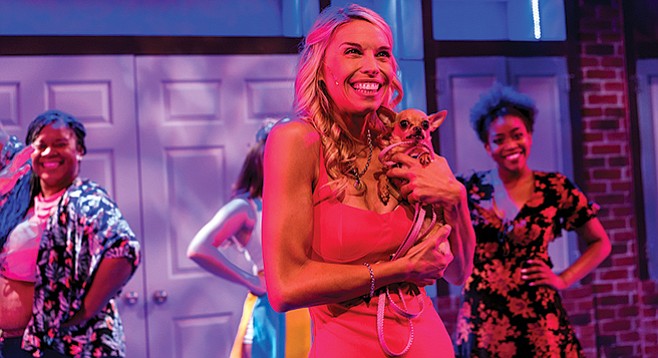 Facebook
Facebook
 X
X
 Instagram
Instagram
 TikTok
TikTok
 Youtube
Youtube

When we attend a Shakespeare performance, there’s typically an expectation the performers will adopt something of a British accent. The Bard’s iambic English, it must be surmised, sounds more authentic when delivered with British inflections: lots of schwas for example, or dropping the R sound after a vowel so that instead of "rather," even an American performer will pronounce it rahthah.
Ironically, Shakespeare probably pronounced his R’s with more rhoticity than these modern-day players do. Linguists tell us dropping the R did not become fashionable in England til the 18th century; a couple centuries after he started writing.
Thanks to heavy trade with American colonies during that time, this English vogue gained favor around shipping ports along our eastern seaboard. It’s why, as distinct as they are from one another, traditional New England, New York, and Southern accents continue to drop the R in this fashion.
As with British, the southern accent has long stood out as favored acting trope of film and stage. When crafting theatrical personas, actors appear to love having such luxuriously drawling accents to chew on. Sure, some roles come so steeped in regional character the script demands it. But oftentimes I suspect performers seek every opportunity to ditch the flatness of the Midwest American cadence so dominant in popular culture, and fit their mouths around unnatural enunciations for the fun of it.
Another fun-for-actors lilt arose out of the 20th century: the Southern California blonde. Primarily a female stereotype, it’s usually applied to a privileged, suburban valley girl or beach-bunny type. It pronounces its R’s and doesn’t drawl. Instead, it’s characterized by a chipper, fast-tempo patter, prone to hyperbole and melodrama, and peppered with vocal quirks such as uptalk or vocal fry.
Though we can point to specific instances appearing in performances going back four decades, it’s almost universally attributed to young women, and most often teens. Not coincidentally, a spate of recent linguistic studies question whether or not adolescents are historically responsible for steering the English language into new colloquial directions.
It sounds plausible. Though not yet as culturally prevalent as British or Southern tropes in high art and cinema, the proliferation of this newer character-type has been rapid, no doubt due in large part to Hollywood sitting right in the thick of California blonde ground zero, where filmmakers’ daughters routinely fit the description.
It clearly doesn’t just manifest in California anymore, or in blondes for that matter. Today we may hear variations of it outside of movies and TV, where it’s steadily creeping into the realm of celebrity, punditry, and even public radio. Perhaps 400 years from now, the stagey cadence of the California blonde will become actors’ favored theatrical accent for authentic delivery of circa 20th century American speech. Perhaps it’s already started, as with the musical stage production of the 2001 film Legally Blonde, playing at the New Village Arts Theater until September 9.


When we attend a Shakespeare performance, there’s typically an expectation the performers will adopt something of a British accent. The Bard’s iambic English, it must be surmised, sounds more authentic when delivered with British inflections: lots of schwas for example, or dropping the R sound after a vowel so that instead of "rather," even an American performer will pronounce it rahthah.
Ironically, Shakespeare probably pronounced his R’s with more rhoticity than these modern-day players do. Linguists tell us dropping the R did not become fashionable in England til the 18th century; a couple centuries after he started writing.
Thanks to heavy trade with American colonies during that time, this English vogue gained favor around shipping ports along our eastern seaboard. It’s why, as distinct as they are from one another, traditional New England, New York, and Southern accents continue to drop the R in this fashion.
As with British, the southern accent has long stood out as favored acting trope of film and stage. When crafting theatrical personas, actors appear to love having such luxuriously drawling accents to chew on. Sure, some roles come so steeped in regional character the script demands it. But oftentimes I suspect performers seek every opportunity to ditch the flatness of the Midwest American cadence so dominant in popular culture, and fit their mouths around unnatural enunciations for the fun of it.
Another fun-for-actors lilt arose out of the 20th century: the Southern California blonde. Primarily a female stereotype, it’s usually applied to a privileged, suburban valley girl or beach-bunny type. It pronounces its R’s and doesn’t drawl. Instead, it’s characterized by a chipper, fast-tempo patter, prone to hyperbole and melodrama, and peppered with vocal quirks such as uptalk or vocal fry.
Though we can point to specific instances appearing in performances going back four decades, it’s almost universally attributed to young women, and most often teens. Not coincidentally, a spate of recent linguistic studies question whether or not adolescents are historically responsible for steering the English language into new colloquial directions.
It sounds plausible. Though not yet as culturally prevalent as British or Southern tropes in high art and cinema, the proliferation of this newer character-type has been rapid, no doubt due in large part to Hollywood sitting right in the thick of California blonde ground zero, where filmmakers’ daughters routinely fit the description.
It clearly doesn’t just manifest in California anymore, or in blondes for that matter. Today we may hear variations of it outside of movies and TV, where it’s steadily creeping into the realm of celebrity, punditry, and even public radio. Perhaps 400 years from now, the stagey cadence of the California blonde will become actors’ favored theatrical accent for authentic delivery of circa 20th century American speech. Perhaps it’s already started, as with the musical stage production of the 2001 film Legally Blonde, playing at the New Village Arts Theater until September 9.
Comments